Free CompanyCam Alternatives
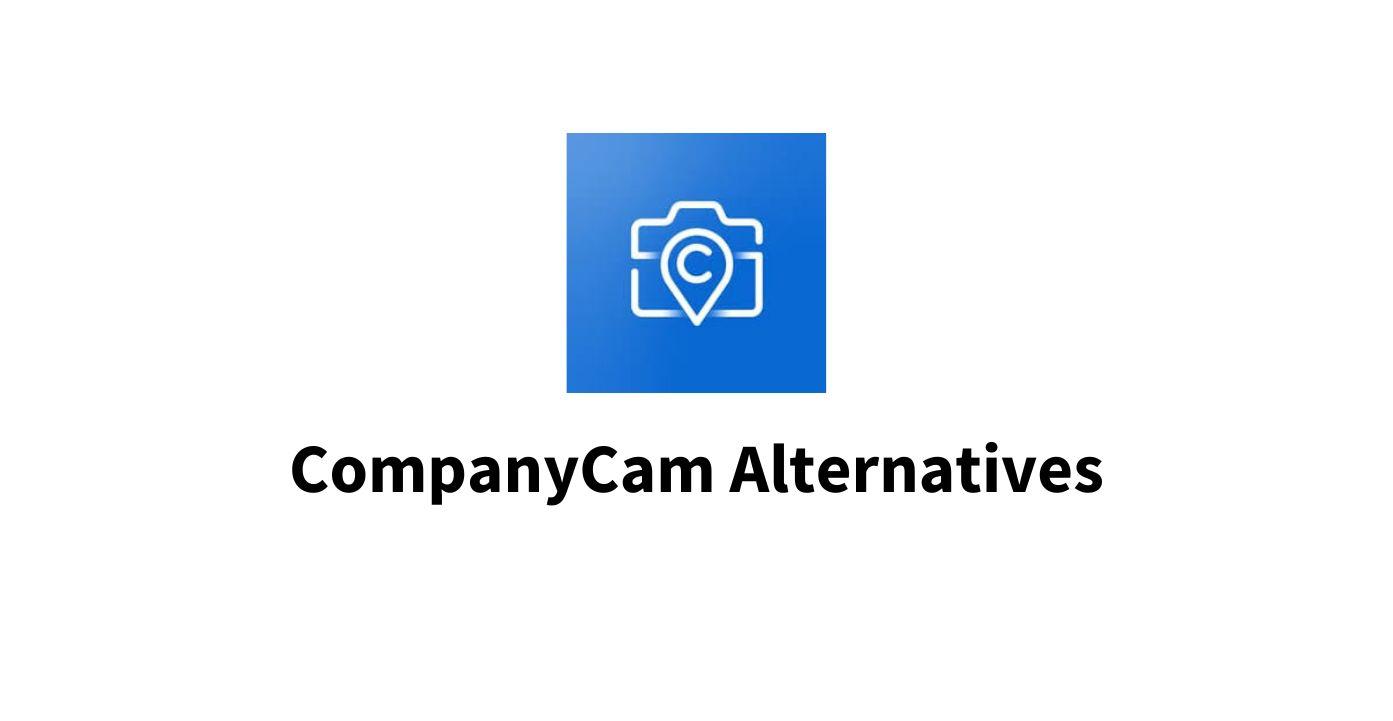
In construction, photo documentation is essential for tracking progress and resolving disputes. But not every tool fits every budget or team size. This article explores affordable alternatives to CompanyCam for managing construction site photos, from free options like smartphone cameras to professional platforms like CrewCam, BuilderComs, Fieldwire, and PlanGrid. Here's a quick breakdown:
- Device Photos: Free and simple but lacks organization and collaboration tools.
- CrewCam: Starts at $39/month with features like GPS tagging, annotations, and unlimited cloud storage.
- BuilderComs: Combines photo documentation with project management but may feel overwhelming for small teams.
- PlanGrid: Part of Autodesk Build, offering advanced tagging and photo reports, but unavailable to new users.
- Fieldwire: Strong photo management and project coordination tools, with added complexity for basic needs.
Choosing the right tool depends on your team's size, budget, and documentation needs. Free options work for small teams, but professional tools save time and improve efficiency as projects grow.
CompanyCam Alternative: We Built a Better Job Site Photo App
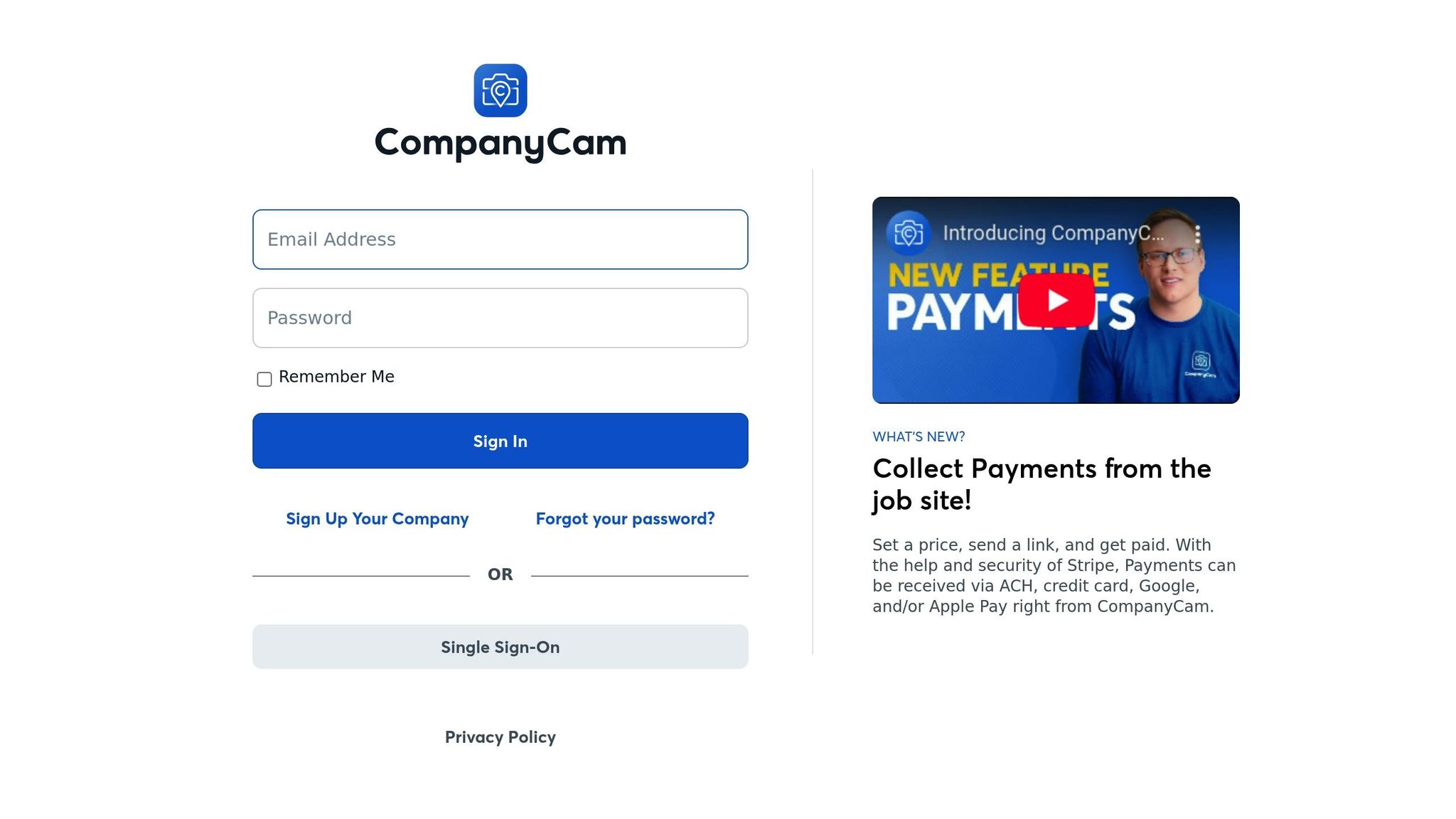
1. Device Photos
Using a smartphone or tablet for construction photo documentation is often the easiest and most accessible option. Chances are, the device you already carry has a camera capable of capturing high-quality images, making it a no-cost solution to get started with documenting your projects.
Cost
The beauty of using your smartphone or tablet is that it doesn’t add to your expenses. Since you’re already paying for the device and its data plan, there are no extra subscription fees, licensing costs, or hardware investments. For construction teams working with limited budgets, this is a practical and budget-friendly way to begin systematic photo documentation.
Photo Documentation Features
Modern smartphones come with built-in features that simplify photo documentation. For example, they automatically embed time and date stamps into every photo, creating metadata that can be crucial for reporting or resolving disputes later on. Features like HDR (High Dynamic Range) improve photo quality in tricky lighting, while wide-angle lenses allow you to capture larger sections of a job site in a single frame.
That said, there are some limitations. Without an organized system, photos can easily get lost in personal storage or buried in emails. According to research, teams spend an average of 9.1 hours per week searching for misplaced project photos. Another drawback is the lack of built-in annotation tools, which can lead to missing context. Without clear notes, it’s harder to interpret what each photo is meant to show, whether it’s progress, an issue, or a detail requiring attention.
Collaboration Tools
Sharing device photos is straightforward but limited. Most teams rely on emails, text messages, or basic cloud services like Google Photos or iCloud to share images. While these methods work for smaller teams, they can become inefficient as projects grow or involve more stakeholders. Without a centralized system for organizing, commenting, or tracking, conversations and documentation can become scattered, making it harder to maintain a clear timeline or ensure everyone is on the same page.
Ease of Integration
Photos taken on smartphones or tablets naturally fit into existing workflows. Construction teams already use their devices for daily communication, so the learning curve is virtually nonexistent. If someone knows how to snap a personal photo, they can document construction progress just as easily. However, integrating these photos into formal project management systems requires manual effort. Without a centralized system, this process can be time-consuming and prone to errors.
"I don't trust words, I trust pictures." – Gilles Peress
This quote resonates strongly in construction, where pictures often provide the clearest, most reliable form of documentation. Visual evidence cuts through the ambiguity of written reports, offering a straightforward way to track progress or address concerns.
While smartphones and tablets offer a free and convenient way to document projects, they come with challenges. Lack of built-in tools for organization, annotation, and collaboration means teams need to establish consistent practices - like creating clear folder structures and taking photos on a regular schedule. These limitations highlight the need for more structured and efficient methods for managing construction photo documentation.
2. CrewCam
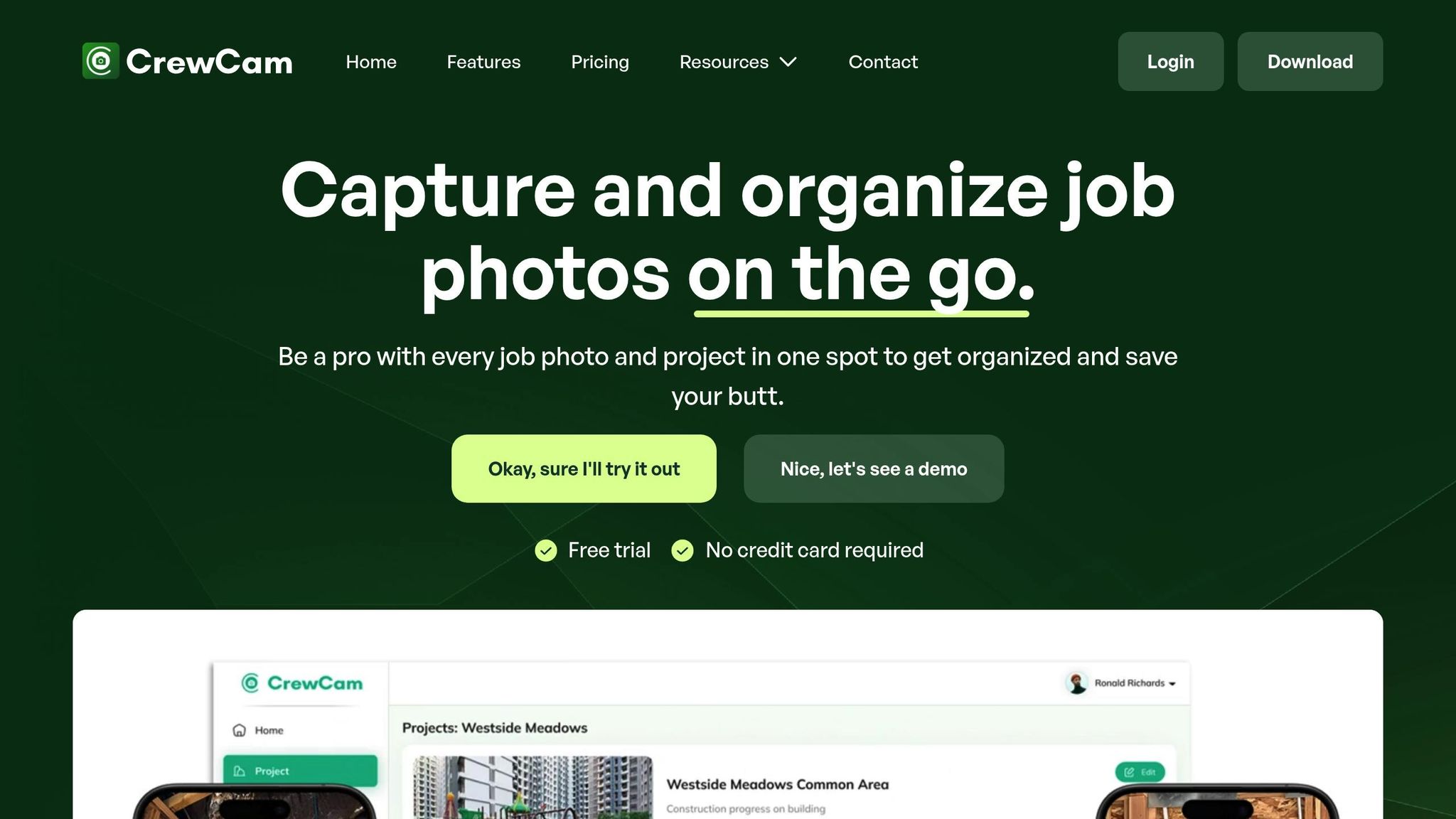
CrewCam transforms the way contractors and construction teams handle photo documentation, turning simple smartphone snapshots into a fully functional platform. It tackles the common challenges of organizing and sharing photos while keeping the process straightforward and user-friendly.
Cost
CrewCam offers flexible pricing to fit the needs of different teams. Here’s a breakdown:
- Basic Plan: $39 per month for up to 2 team members
- Standard Plan: $89 per month for up to 5 team members
- Premium Plan: $224 per month for up to 15 team members
- Enterprise Solutions: Custom pricing for larger organizations
While CrewCam isn’t free, its tailored features and unlimited cloud storage make it a worthwhile investment for professionals who need dependable photo documentation.
Photo Documentation Features
CrewCam goes beyond the basic capabilities of smartphone cameras. Every photo and video is automatically tagged with GPS location data and timestamps, creating reliable records that are perfect for resolving disputes or meeting compliance requirements. The platform also offers unlimited cloud storage and organizes images by project, so finding the right photo is quick and easy. Plus, its live photo feed ensures everyone stays updated in real time, eliminating delays caused by manual uploads.
One standout feature is the ability to annotate photos. Users can draw, add text, and leave comments directly on images, providing essential context that enhances communication and documentation. As CrewCam explains:
"Capture and organize job photos on the go. Be a pro with every job photo and project in one spot to get organized and ensure you are fully prepared for any onsite issue." – CrewCam
Beyond photo organization, CrewCam includes task management tools. Teams can create visual checklists, confirm task completion with photos, and maintain accountability throughout the project.
Collaboration Tools
Sharing photos and updates is effortless with CrewCam’s collaboration tools. Teams can invite contractors, subcontractors, and even homeowners to join projects. Guest access allows contributors to upload photos, add comments, and ask questions without needing paid accounts. A sharable photo gallery makes it simple to select and distribute specific images. Combined with real-time updates through the live project feed, these features ensure that everyone involved stays informed and connected.
This streamlined approach to collaboration and documentation sets the foundation for comparing other platforms later.
Ease of Integration
CrewCam understands that construction teams often rely on multiple software tools, so it’s designed to integrate smoothly into existing workflows. While maintaining the simplicity of smartphone photography, it adds powerful features like automated organization, cloud backups, and easy sharing, all tailored to the demands of professional construction projects.
"Avoid liability by being organized with job photos date and time stamped, organized by job, and keeping your team accountable." – CrewCam
Considering that teams can lose up to 35% of their time troubleshooting tools, CrewCam’s efficiency-focused design significantly reduces wasted time and effort.
3. BuilderComs
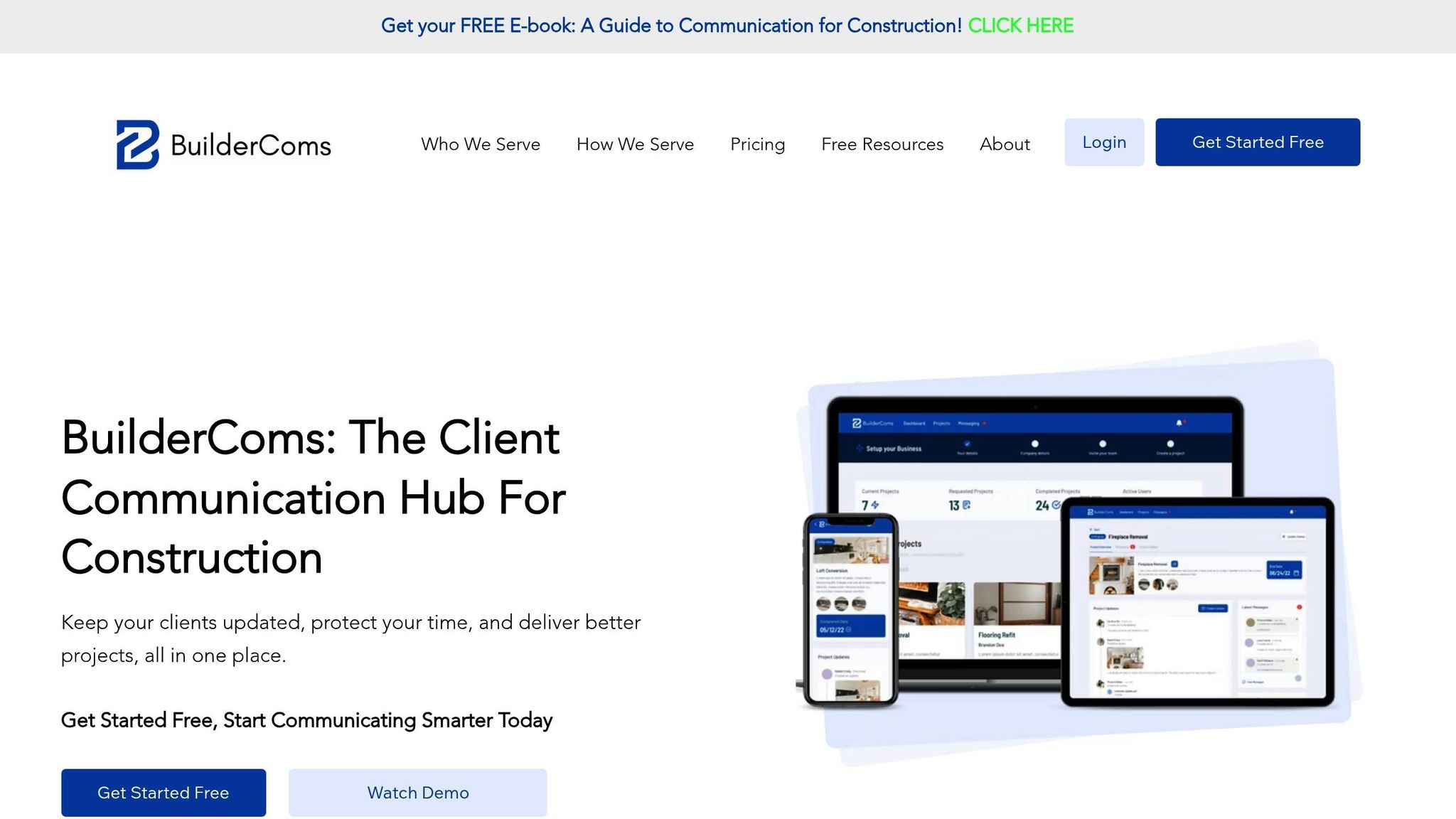
BuilderComs is another standout option for construction photo documentation, following in the footsteps of CrewCam. This all-in-one platform combines photo documentation, image storage, and project management tools to simplify construction workflows.
Photo Documentation Features
BuilderComs organizes photos by tagging and linking them to specific project milestones. This creates a clear, visual timeline that tracks progress, identifies potential issues early, and provides transparent documentation for clients. These features make it easier to maintain smooth communication throughout a project.
Collaboration Tools
BuilderComs offers tools like real-time messaging, mobile-friendly access, and automated safety updates to streamline team communication. Miscommunication is costly - teams lose up to $4,000 per employee annually, and rework accounts for 22% of project costs. By centralizing communication, BuilderComs reduces the need to switch between emails, texts, and various apps.
A dedicated client app ensures clients have direct access to project details. Patrick Robertson, owner of Momentous Building, highlights the platform's convenience:
"We were always running into issues bouncing from platform to platform. Usually, it goes from email, text messages, and phone calls. I'm happy I joined [BuilderComs] because now, what I have the ability to do is have one centrally located platform where I can communicate with customers in one place."
Teams can also set up dedicated messaging channels and share documents effortlessly, keeping everyone informed without overwhelming them. These tools integrate seamlessly into existing workflows, making collaboration smoother.
Ease of Integration
BuilderComs is designed to complement, not replace, the tools teams already use. It integrates with over 6,000 apps, including Autodesk, QuickBooks, Microsoft Project, Slack, and Procore, reducing manual data entry and simplifying workflows. For example, JobTread users benefit from automated customer updates and document synchronization. As Ron Nussbaum, CEO of BuilderComs, explains:
"With our Construction Communication Management Solution, we're taking on the communication burden so businesses can focus on what they do best, building projects on time and within budget."
These integration features make BuilderComs particularly useful for teams juggling multiple construction management tools, helping them improve communication and boost efficiency.
sbb-itb-5f4c686
4. PlanGrid
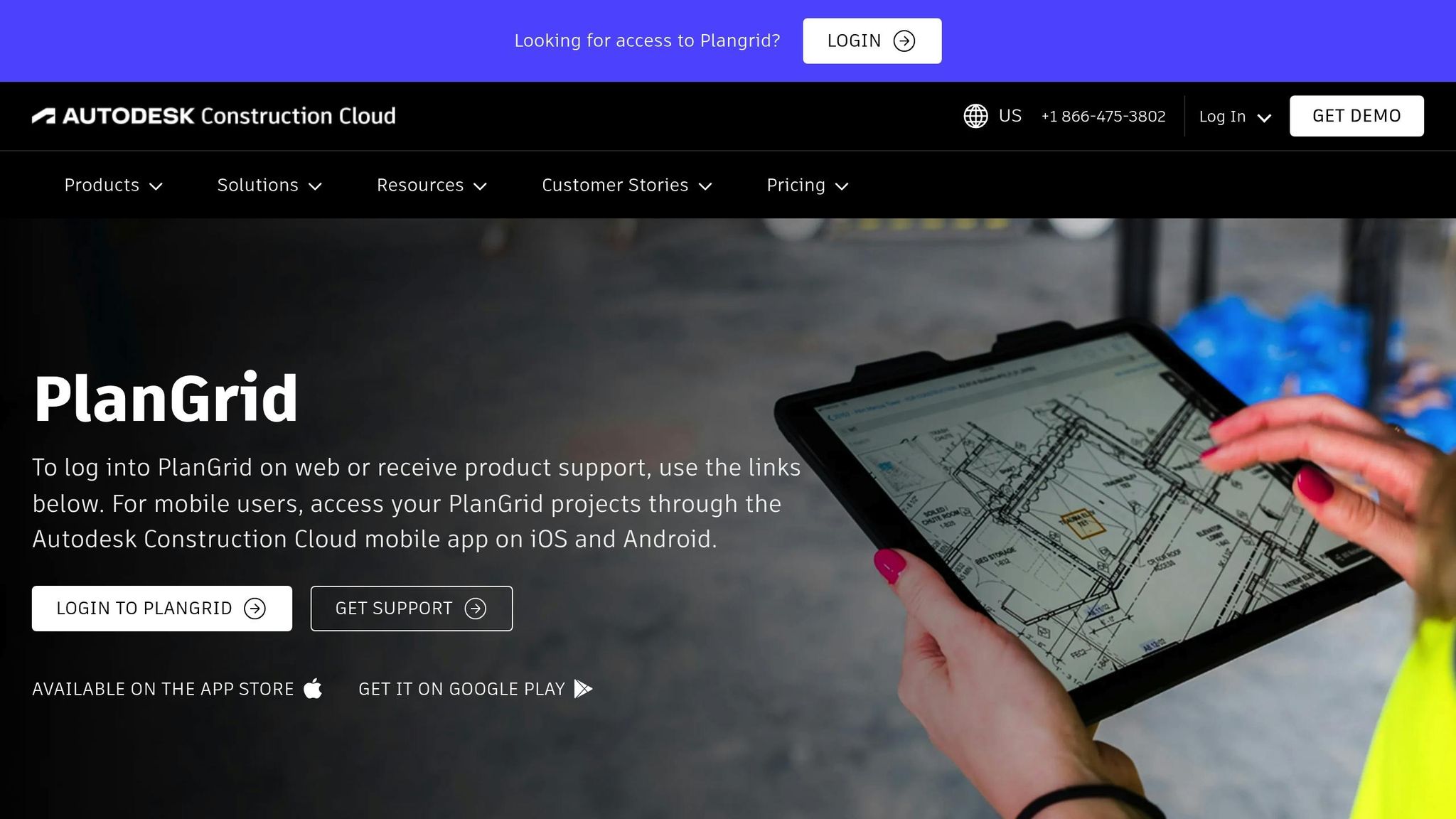
PlanGrid has been integrated into Autodesk Build, which is part of the Autodesk Construction Cloud ecosystem. While it’s no longer available for purchase by new customers, existing users still benefit from its robust photo documentation tools within the Autodesk platform.
Photo Documentation Features
PlanGrid excels in photo management by allowing users to create custom tags to organize images. These personalized tags make it simple to categorize and quickly locate specific photos or documentation when needed. Its search feature further enhances efficiency, enabling teams to filter photo galleries based on these tags and save time when searching for particular images or videos.
Beyond basic storage, PlanGrid links data directly to photos, enabling users to generate photo reports. A centralized gallery allows for sorting and filtering, ensuring construction professionals maintain well-organized visual records throughout a project's lifecycle. This structured system supports real-time collaboration, helping teams stay aligned on project progress.
Collaboration Tools
Collaboration is central to PlanGrid’s functionality. The platform ensures all stakeholders have access to the most up-to-date information, preventing the confusion caused by outdated files. Teams can share updates, annotate blueprints, and mark up essential documents, simplifying the review and approval process.
PlanGrid also provides a unified system for data collection and issue tracking. Construction teams can capture, manage, and analyze project data as work progresses. With custom reports and dashboards, teams can monitor performance and effectively communicate results to clients and management, keeping everyone informed and on the same page.
Ease of Integration
PlanGrid’s integration within the Autodesk Construction Cloud ecosystem enhances its already strong documentation and collaboration features. By streamlining data transfers between design and modeling tools, it reduces manual data entry and minimizes errors.
For example, when connected with CMiC construction management software, RFIs (Requests for Information) can be submitted through various channels - whether by a senior team member at a desktop, an office executive via email, or a field worker using PlanGrid on a mobile device. This integration ensures all RFIs are stored, tracked, and accessible from a central location, improving communication and data sharing across the project team.
This unified approach eliminates redundant data entry across systems. Field data captured in PlanGrid flows seamlessly to other connected platforms, maintaining organization, boosting productivity, and strengthening collaboration among team members using different construction management tools.
5. Fieldwire

Fieldwire supports over 2 million jobsites worldwide, offering a blend of organized photo documentation and robust project management tools.
Photo Documentation Features
Fieldwire stands out with its photo management capabilities, making it easy to upload and organize images. Photos can be added from various sources like your computer, Box, Google Drive, OneDrive, or OneDrive Business, with support for common formats and file sizes up to 50MB. Once uploaded, images are automatically sorted by their upload date, simplifying file management. The platform also includes tools to mark up photos with lines, arrows, and text, as well as tagging features to group and locate images quickly [43, 47]. Teams can use advanced filters to sort photos by linked items (like plans, tasks, or forms), tags, uploader, or upload date. For Business users, Fieldwire even supports 360° photos using Ricoh Theta cameras, offering an immersive way to document job sites [43, 47].
Each photo includes GPS coordinates and timestamps, tying images directly to specific locations on a project [43, 45, 47]. Photos can be shared via email in either their original resolution or an optimized 1200 x 1200px format, with filenames that include the upload date and time.
"Fieldwire absolutely saves us time. It saves us countless man-hours and prevents tons of mistakes... I'll have detailed photos and measurements of everything stored in Fieldwire before the walls even go up, so I can always go back and reference them." - Joshua Harsono, Service Delivery Manager, Event Operations, Facebook
These features not only streamline documentation but also enhance team collaboration.
Collaboration Tools
Fieldwire brings project teams together with real-time messaging tied to specific tasks and push notifications to keep everyone in sync. The platform supports task assignments, real-time comments, and even video conferencing, while allowing access to the latest drawings across devices [48, 54]. Teams can set up custom workflows, assign responsibilities, and track progress through a centralized dashboard. Its task management system includes features like related tasks and quick-assign shortcuts using "@" and "#" symbols for faster collaboration. Automatic status updates and customizable progress reports ensure teams stay on track, with the ability to revisit completed or archived projects whenever needed.
"Fieldwire is great because you can capture and control all your data all in one spot. I bet you it has probably saved us 2-3 QA/QC people on our project, in all honesty." - Mike Armstrong, Assistant PM at EllisDon
Fieldwire’s real-world impact is clear. Kylie Schalz, Senior Engineer at Fuse Consulting Engineers, shared that before using Fieldwire, preparing reports and managing over 1,000 photos took 10–15 hours per report each week - consuming 70% of the team's office time.
Ease of Integration
Fieldwire integrates seamlessly with other software, creating a unified platform for project data. It connects with popular cloud storage services like SharePoint, OneDrive, Google Drive, Dropbox, and Egnyte, as well as calendars like Outlook and Google Calendar. Data analysis tools like Power BI, Excel, and Google Sheets also sync with Fieldwire, enabling automatic blueprint updates and centralized task tracking. Teams integration ensures stakeholders stay informed with notifications about project changes. Best of all, the setup process is simple and requires no additional tools or APIs.
"Fieldwire app integrations solve this problem by connecting the data from multiple software, so your teams can have one single source of truth." - Julien Herbulot, Product Manager
The platform provides a clear overview of active integrations, their statuses, and the projects they support. Users report saving up to an hour each workday thanks to these streamlined integrations.
Benefits and Drawbacks
Here’s a closer look at the pros and cons of each solution, helping you weigh your options and choose what fits your team best.
Device photos are as simple as it gets - no cost and no learning curve. But as your projects expand, organizing and retrieving specific images can become a major headache. What starts as a quick fix can end up being a time drain as project complexity grows.
CrewCam offers a solid balance between affordability and functionality, with plans starting at $39 per month for up to two users. The downside? Its pricing tiers limit the number of users - just two on the Basic plan and five on the Standard plan - making it less ideal for bigger teams.
BuilderComs brings everything together by combining photo documentation with project management tools. This setup can simplify workflows and reduce the need for multiple apps or subscriptions. On the flip side, the platform’s setup process can feel overwhelming, and smaller teams might find its features more than they need for basic documentation.
PlanGrid stands out with its custom tagging for photos and seamless integration into the Autodesk Construction Cloud ecosystem. However, it’s no longer an option for new customers, as it’s only available to those already using Autodesk subscriptions.
Fieldwire supports over 2 million jobsites, offering powerful photo management paired with project coordination tools. While its capabilities are impressive, teams looking for straightforward photo documentation may find the platform’s depth requires extra training.
Here’s a quick cost and feature breakdown:
| Solution | Monthly Cost | Key Strengths | Main Limitations |
|---|---|---|---|
| Device Photos | $0 | Easy to use, no cost | Poor organization and sharing |
| CrewCam | $39–$224/month | Balanced features, unlimited storage | User limits per pricing tier |
| BuilderComs | Varies | All-in-one platform | Time-intensive setup |
| PlanGrid | Through Autodesk | Custom tags, integration with Autodesk | Not available for new customers |
| Fieldwire | Varies | Comprehensive project management | Complex for simple documentation |
While subscription fees are a factor, it’s worth considering the hidden costs. Free solutions like device photos save money upfront but can eat up time with manual organization. Mid-range options such as CrewCam streamline workflows without overwhelming users, while enterprise-grade tools provide extensive features that come at a higher price.
Scalability is another key consideration. Small teams might do just fine with device photos or CrewCam’s Basic plan, but as your team grows, you’ll need a solution that can add users without ballooning costs.
Lastly, think about the learning curve. Device photos require no training, but more advanced platforms may need extra setup and onboarding to make the most of their features. Consider how tech-savvy your team is and whether you have the resources to train them.
Each solution has its strengths and trade-offs, catering to different needs - from simple documentation to fully integrated project management.
Final Thoughts
This summary pulls together the key insights from our comparison. Selecting the best construction photo documentation tool boils down to aligning the tool’s features with your team’s specific needs.
For smaller teams just starting out, using device photos can be a cost-effective option since it doesn’t require additional spending. However, as teams grow, this method often becomes inefficient due to challenges in organization and accessibility.
When basic tools reach their limits, dedicated platforms become essential. CrewCam stands out as an excellent choice for small to medium-sized teams seeking a straightforward yet powerful photo management solution. Priced at $39 per month for two users, it offers unlimited cloud storage, GPS and time-stamped photos, and collaboration features that simplify team workflows. Its emphasis on visual documentation fits seamlessly into construction projects, where maintaining clear and organized photo records is critical.
Budget considerations, however, go beyond just subscription costs. As Hassan Iqbal, Assistant Administration Technical Manager, explains:
"Apart from other factors its important to consider Ease of Use and Customization. We must ensure the WMT serves the purpose for each stakeholder and should be adaptive to changing requirements."
Hidden costs, such as the time spent manually organizing device photos or the challenges of learning overly complex platforms, can sometimes outweigh the perceived savings of free or low-cost options.
For solo contractors or smaller crews, CrewCam’s Basic plan offers enough functionality. On the other hand, larger teams may need to explore more advanced solutions to meet their demands.
In today’s construction industry, digital documentation is no longer optional - it’s a necessity. While free options can serve short-term needs, scalable tools like CrewCam provide efficient, reliable documentation without unnecessary complications. The key is to choose a tool that grows alongside your team and projects.
FAQs
Why should I use a dedicated tool like CrewCam instead of just taking photos with my smartphone for construction projects?
Using a specialized tool like CrewCam keeps your construction project photos neatly organized, timestamped, and stored in one central hub. This setup simplifies tracking progress, spotting potential problems early, and ensuring everyone on the team stays accountable.
Standard smartphone photos can be a hassle - they often lack context, proper organization, or get misplaced altogether. Tools like CrewCam take the guesswork out of documentation by automatically organizing images and attaching essential details like dates and project-specific tags. The result? You save time and always have dependable, easily accessible records at your fingertips.
How does CrewCam improve team communication and project management compared to simply sharing photos?
CrewCam elevates team collaboration by providing tools like real-time updates, GPS-tagged and time-stamped photos, and live commenting. These features make it easy for your team to stay aligned with accurate records and instant communication, keeping project management efficient and well-organized.
What sets CrewCam apart from simple photo-sharing apps is its ability to deliver context-rich visuals and updates that everyone can access immediately. This reduces miscommunication, enhances coordination, and ensures projects stay on track from beginning to end.
What should construction teams consider when deciding between free photo tools and paid options like CrewCam?
When deciding between free photo tools and paid solutions like CrewCam, construction teams need to weigh factors like project size, budget, and documentation requirements. Free tools can be a good fit for smaller projects with straightforward needs, but they often fall short when it comes to advanced features or handling larger-scale operations.
On the other hand, paid platforms such as CrewCam usually offer better organization, more storage, and professional-grade tools, making them well-suited for bigger or more intricate projects. Think about your team’s workflow and how critical features like smooth collaboration and detailed record-keeping are to your success before choosing the right option.
Related Blog Posts
See CrewCam in action


%20(3).svg)





